Shortcuts:
"In
the Beginning" - Unity Between the Nations
by Bryan Dawson
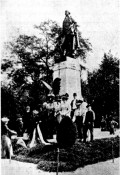 In 1902 a movement started to build a Kossuth statue
in Cleveland spearheaded by the "Szabadság"
Hungarian language newspaper and its editor Kohányi Tihamér.
The needed funds were raised within few short weeks. Some 60,000 people
attended the In 1902 a movement started to build a Kossuth statue
in Cleveland spearheaded by the "Szabadság"
Hungarian language newspaper and its editor Kohányi Tihamér.
The needed funds were raised within few short weeks. Some 60,000 people
attended the 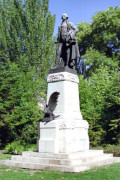 unveiling, but there were no representatives from Hungary. unveiling, but there were no representatives from Hungary.
As
a sign of unity between the nations, Hungarian-American leaders conceived
an idea to place a statue of George Washington in Budapest.
The newly established AHF and its "Statue Committee"
was organized and construction began on a site in Budapest's beautiful
City Park (Város Liget). In 1906, several hundred Hungarian-Americans
traveled to Hungary for the unveiling led by AHF's first President, Kohányi
Tihamér.
[read more]
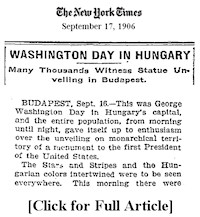 Tihamér Kohányi - (1863 - 1913) Tihamér Kohányi - (1863 - 1913)
AHF's First President - edited by Bryan Dawson
Tihamér Kohányi was born in 1863 in Saros, Hungary. He became an outstanding figure in the establishment of several major Hungarian-American institutions, among them the Szabadság, which became the largest Hungarian daily in the United States and the American Hungarian Federation. After a try in the legal profession, Kohányi departed for the United States in 1890 at the age of twenty-seven. At the time of his departure, he wrote:
I left [for America with light heart and baggage, with the strong conviction--on the basis of what I had heard from many-that no one has ever died of hunger in America. [read more]
"Justice for Hungary"
- an Historic Transatlantic Flight
by Bryan Dawson
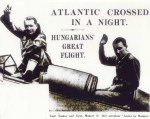 July,
1931, newspapers all over the world reported on the front page that two
Hungarian pilots, Alexander Magyar and George Endresz (Endres), had crossed
the Atlantic Ocean from the United States to Hungary in a Lockheed-Sirius
airplane named "Justice for Hungary." The flight was intended
to call attention to the dismemberment of Hungary after World War I. It
was a spectacular success. July,
1931, newspapers all over the world reported on the front page that two
Hungarian pilots, Alexander Magyar and George Endresz (Endres), had crossed
the Atlantic Ocean from the United States to Hungary in a Lockheed-Sirius
airplane named "Justice for Hungary." The flight was intended
to call attention to the dismemberment of Hungary after World War I. It
was a spectacular success. 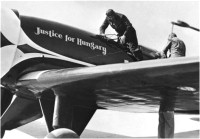 On
July 15, 1931, the trans-Oceanic flight left Harbor-Grace for Budapest
on a non-stop flight of twenty-six hours. The historic flight took 26
hours and 20 minutes (Charles Lindbergh's flight in 1927 took six hours
longer) and marked the first time that an airplane crossing the ocean
had radio contact both with the starting and landing aerodromes. It was
also the first time such a flight was used for political purposes. The
pilots were received as heroes in Budapest. On
July 15, 1931, the trans-Oceanic flight left Harbor-Grace for Budapest
on a non-stop flight of twenty-six hours. The historic flight took 26
hours and 20 minutes (Charles Lindbergh's flight in 1927 took six hours
longer) and marked the first time that an airplane crossing the ocean
had radio contact both with the starting and landing aerodromes. It was
also the first time such a flight was used for political purposes. The
pilots were received as heroes in Budapest.
Where did this idea come from? [read
more]
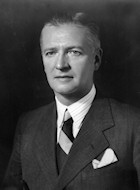 AHF, Tibor Eckhardt, and
the "Movement for Independent Hungary," 1941 - 1942: Seeking to extract Hungary
from
the Axis sphere - by Bryan Dawson and Katalin Kádár Lynn, Ph.D. AHF, Tibor Eckhardt, and
the "Movement for Independent Hungary," 1941 - 1942: Seeking to extract Hungary
from
the Axis sphere - by Bryan Dawson and Katalin Kádár Lynn, Ph.D.
On the 31st of
December 1940, the Amerikai Magyar Népszava, the most
influential Hungarian language daily at the time, published a front-page editorial headlined “The Hour has Struck.” The
editorial proclaimed that it was the “the historic mission
of Americans of Hungarian origin to give voice to the
cries of the silenced people of Hungary and to give their
whole hearted effort to the liberation of their mother
country which is clubbed into submission by the Nazi terror.”
The editorial called upon the American Hungarian
Federation to unfurl the banner of a Free Hungary
Movement without hesitation or delay. In January
1941 AHF 's Executive Committee sent a letter to
President Roosevelt expressing the loyalty of the
Hungarian-American populace and proclaiming,“The Executive Committee of the [AHF] as
representative of the American citizens of
Hungarian origin…consider it our sacred duty to
lead a movement for the preservation of an independent Hungary for the freedom of it’s people.” [read more]
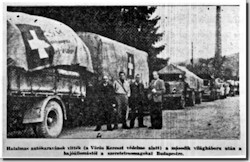 WWII and the American Hungarian Relief Program... According to
estimates, 50,000 Hungarian-Americans served in the U.S.
military during the Second World War. The newspapaper
Szabadság (Liberty) commemorated the Hungarian-American dead by printing their name, rank and state
of origin in a separate column on the front page of each
issue. On the basis of this documentation alone, an average
of 150 Hungarians died each month in 1945 alone. By all
calculations, this is a conservative estimate.The American Hungarian Relief Program, under the auspices of the American Hungarian Federation, collected and sent $1,216,167.00 (over $10.7 million in today's dollars) in clothing, medicine, foodstuffs and money. In all, 200,000 care packages were sent by countless local and national groups. Total estimated costs of the relief program exceeded three million dollars. [read more] WWII and the American Hungarian Relief Program... According to
estimates, 50,000 Hungarian-Americans served in the U.S.
military during the Second World War. The newspapaper
Szabadság (Liberty) commemorated the Hungarian-American dead by printing their name, rank and state
of origin in a separate column on the front page of each
issue. On the basis of this documentation alone, an average
of 150 Hungarians died each month in 1945 alone. By all
calculations, this is a conservative estimate.The American Hungarian Relief Program, under the auspices of the American Hungarian Federation, collected and sent $1,216,167.00 (over $10.7 million in today's dollars) in clothing, medicine, foodstuffs and money. In all, 200,000 care packages were sent by countless local and national groups. Total estimated costs of the relief program exceeded three million dollars. [read more]
 AHF and the 1956 Hungarian Revolution by Bryan Dawson... AHF and the 1956 Hungarian Revolution by Bryan Dawson...
Hungary's 1956 Revolution marked the first tear in the Iron Curtain. Hungarians from all walks of life rose up
against the mighty Soviet Union in a desperate fight for freedom. Thousands died, many othes tortured and jailed,
200,000 would flee, bringing untold talents to the shores of many nations, some 38,000 coming to the U.S.
AHF, member
organizations and the entire community sprung into action. Building on its experience during WWII, AHF activated its second
Hungarian Relief Program, raising over $525,000 and,working closely with the International Relief Committee,
found beds and supplies to aid in the resettlement effort. At Madison Square Garden 10,000 people gathered to raise
one million dollars for Hungarian relief. [read more]
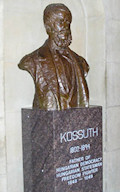 The Kossuth Bust in the United States Capitol - "A gift from the American Hungarian Federation to the People of the United States" - The Kossuth Bust in the United States Capitol - "A gift from the American Hungarian Federation to the People of the United States" -
by Bryan Dawson...
"The spirit of our age is Democracy. All for the people and all by the people. Nothing about the people, without the people. That is Democracy, and that is the ruling tendency of the spirit of our age." - Louis Kossuth, spoken before the Ohio State Legislature, February 16, 1852, more than a decade before Lincoln's Gettysburg Address.
 The American Hungarian Federation commisioned a bronze bust of Lajos Kossuth and presented it to U.S. Congress. The dedication ceremony took place on March 15, 1990, Hungarian National Day, under the magnificent dome of the Capitol Rotunda. The bust is one of only two honoring non-Americans in the Capitol. The base reads, "Louis Kossuth, Father of Hungarian Democracy." [read more] The American Hungarian Federation commisioned a bronze bust of Lajos Kossuth and presented it to U.S. Congress. The dedication ceremony took place on March 15, 1990, Hungarian National Day, under the magnificent dome of the Capitol Rotunda. The bust is one of only two honoring non-Americans in the Capitol. The base reads, "Louis Kossuth, Father of Hungarian Democracy." [read more]
 AHF and the Divided Village of Szelmenc: "A kettévágott falu" by Bryan Dawson... AHF and the Divided Village of Szelmenc: "A kettévágott falu" by Bryan Dawson...
A Most Painful Division... Although brother and sister have lived in the same village all their lives, Maria Ivan and her brother, Arpad, have been able to hug each other only twice in the past 53 years. As a result of a post-World War II treaty, a barbed wire fence marking borders has divided them.
Szelmenc (called Solontsi in Ukrainian and Velke Slemence in Slovak) is found near where the Ukrainian, Slovakian and Hungarian borders meet. After WWII, the Soviets took this part along with half of the village for themselves. The other half was given to Czechslovakia. With the disintegration of the Soviet Union, the Soviet part became part of Ukraine. [read more]
The Szabadka Initiative (MÁÉRT)
by Bryan Dawson
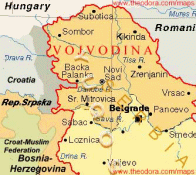 AHF attended this historic meeting and signed a joint declaration
by ethnic Hungarian political parties and human rights
organizations from successor atates in an appeal to the
Hungarian Government for more coherent support,
coordinated planning, and dual citizenship. AHF was
among fifteen organizations from Europe, North America,
and Latin America that met
January 5-6, 2005 in
Szabadka (Subotica) in the
Vajdaság (Vojvodina), a formerly autonomous region
in Serbia-Montenegro, and joined forces to persuade
the Hungarian Government to coordinate with them
efforts aimed at assisting ethnic Hungarians living as
national minorities in Rumania, Slovakia, Serbia-
Montenegro, Ukraine, Croatia, and Slovenia. The
meeting marked the first time ethnic Hungarian
political organizations met independently of the
Hungarian government. [read more] AHF attended this historic meeting and signed a joint declaration
by ethnic Hungarian political parties and human rights
organizations from successor atates in an appeal to the
Hungarian Government for more coherent support,
coordinated planning, and dual citizenship. AHF was
among fifteen organizations from Europe, North America,
and Latin America that met
January 5-6, 2005 in
Szabadka (Subotica) in the
Vajdaság (Vojvodina), a formerly autonomous region
in Serbia-Montenegro, and joined forces to persuade
the Hungarian Government to coordinate with them
efforts aimed at assisting ethnic Hungarians living as
national minorities in Rumania, Slovakia, Serbia-
Montenegro, Ukraine, Croatia, and Slovenia. The
meeting marked the first time ethnic Hungarian
political organizations met independently of the
Hungarian government. [read more]
[<< Go to All AHF News]
| The 1907 Kohányi Szózat (Appeal)
“Amerika egy millió magyarja, nemcsak hogy követeljük, de keresztül is visszük azt, hogy Magyarország népének ugyanabban a szabadságban, ugyanabban az igazságban, ugyanabban a jólétben legyen resze, mint amely szabadság, igazság, es jólét abban az Amerikában van amelynek lakósai, polgárai vagyunk.”
“We, America’s 1 million Hungarians, do not just demand, but will work to ensure that the people of Hungary may partake in the same freedom, the same justice, the same prosperity as we, citizens of America, partake.”
- Kohanyi Tihamer, AHF President, 1907
AHF's 100 YEARS
CONGRESSIONAL DISPLAY
(by Bryan Dawson:
click on each
image for a larger version)
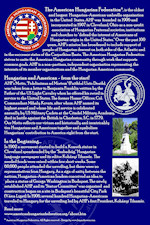
AHF in the Beginning:
1906 and Budapest's
George Washington Memorial
[read more]
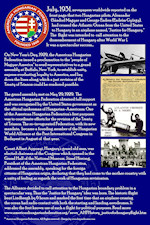
AHF and the "Justice for
Hungary" movement calling
attention to the tragedy of Trianon
[read more]

AHF, Tibor Eckhardt, and
the "Free Hungary Movement"
seeking to extract Hungary
from the Axis sphere
[read more]
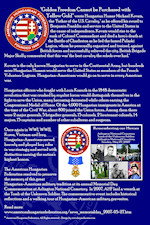
AHF Honoring our
Heroes at the Arlington
National Cemetery
[read more]
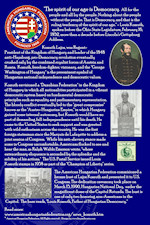
AHF and the Kossuth
Bust in the US Capitol
[read more]

AHF as a watchdog for
human rights in Rumania
[read more]

AHF as a watchdog for
human rights in Vojvodina
and the MÁÉRT movement
[read more]
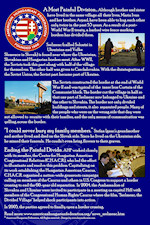
AHF as a watchdog for
human rights in Carpatho-Ukraine:
The Divided Village of Szelmenc
[read more]
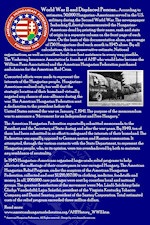
AHF relief efforts during WWII
[Read More]
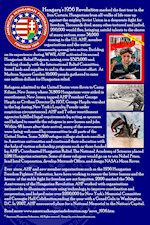
AHF relief efforts during
the 1956 Hungarian Revolution
[read more]
Join online!

Help us help the community!
Support us securely online.
[<< back to all AHF news] |



